Aortic intramural hematoma: Difference between revisions
Jump to navigation
Jump to search
No edit summary |
Devesh Rai (talk | contribs) |
||
| Line 24: | Line 24: | ||
*Conservative management is indicated for aortic intramural hematomas of the descending aorta. | *Conservative management is indicated for aortic intramural hematomas of the descending aorta. | ||
==Historical Perspective== | ==Historical Perspective== | ||
* | *The diagnosis of aortic intramural hematoma dates back to early 1980s when the choice of diagnosis was Trans-esophageal echocardiography. | ||
==Classification== | ==Classification== | ||
| Line 152: | Line 150: | ||
[[Image:Intramural-hematoma-006.jpg|thumb|350px|left|Contrast enhanced CT: Aortic intramural hematoma]] | [[Image:Intramural-hematoma-006.jpg|thumb|350px|left|Contrast enhanced CT: Aortic intramural hematoma]] | ||
<br clear="left"/> | <br clear="left" /> | ||
[[Image:Intramural-hematoma-005.jpg|thumb|350px|left|Contrast enhanced CT: Aortic intramural hematoma]] | [[Image:Intramural-hematoma-005.jpg|thumb|350px|left|Contrast enhanced CT: Aortic intramural hematoma]] | ||
<br clear="left"/> | <br clear="left" /> | ||
[[Image:Intramural-hematoma-007.jpg|thumb|350px|left|Contrast enhanced CT: Aortic intramural hematoma]] | [[Image:Intramural-hematoma-007.jpg|thumb|350px|left|Contrast enhanced CT: Aortic intramural hematoma]] | ||
<br clear="left"/> | <br clear="left" /> | ||
[[Image:Intramural-hematoma-002.jpg|thumb|350px|left|Contrast enhanced CT: Aortic intramural hematoma]] | [[Image:Intramural-hematoma-002.jpg|thumb|350px|left|Contrast enhanced CT: Aortic intramural hematoma]] | ||
<br clear="left"/> | <br clear="left" /> | ||
[[Image:Intramural-hematoma-003.jpg|thumb|350px|left|Contrast enhanced CT: Aortic intramural hematoma]] | [[Image:Intramural-hematoma-003.jpg|thumb|350px|left|Contrast enhanced CT: Aortic intramural hematoma]] | ||
<br clear="left"/> | <br clear="left" /> | ||
[[Image:Intramural-hematoma-004.jpg|thumb|350px|left|Contrast enhanced CT: Aortic intramural hematoma]] | [[Image:Intramural-hematoma-004.jpg|thumb|350px|left|Contrast enhanced CT: Aortic intramural hematoma]] | ||
<br clear="left"/> | <br clear="left" /> | ||
Revision as of 03:03, 9 April 2019
Editor-In-Chief: C. Michael Gibson, M.S., M.D. [1]
Associate Editor-In-Chief: Cafer Zorkun, M.D., Ph.D. [2]
Overview
- It may occur as a primary event in hypertensive patients in whom there is spontaneous bleeding from vasa vasorum into the media or may be caused by a penetrating atherosclerotic ulcer.
- Intramural hematoma may also develop as a result of blunt chest trauma with aortic wall injury.
- Thought to begin with the rupture of the vasa vasorum, the blood vessels that penetrate the outer half of the aortic media from the adventitia and arborize within the media to supply the aortic wall.
- The hematoma propagates along the media layer of the aorta.
- Consequently, intramural hematoma weakens the aorta and may progress either to outward rupture of the aortic wall or to inward disruption of the intima, the latter leading to communicating aortic dissection.
- Unlike aortic dissection, no intimal flap is present.
- If it involves the ascending aorta, treatment is surgical to prevent rupture or progression to a classic aortic dissection.
- Conservative management is indicated for aortic intramural hematomas of the descending aorta.
Historical Perspective
- The diagnosis of aortic intramural hematoma dates back to early 1980s when the choice of diagnosis was Trans-esophageal echocardiography.
Classification
- [Disease name] may be classified according to [classification method] into [number] subtypes/groups:
- [group1]
- [group2]
- [group3]
- Other variants of [disease name] include [disease subtype 1], [disease subtype 2], and [disease subtype 3].
Pathophysiology
- The pathogenesis of [disease name] is characterized by [feature1], [feature2], and [feature3].
- The [gene name] gene/Mutation in [gene name] has been associated with the development of [disease name], involving the [molecular pathway] pathway.
- On gross pathology, [feature1], [feature2], and [feature3] are characteristic findings of [disease name].
- On microscopic histopathological analysis, [feature1], [feature2], and [feature3] are characteristic findings of [disease name].
Clinical Features
Differentiating [disease name] from other Diseases
- [Disease name] must be differentiated from other diseases that cause [clinical feature 1], [clinical feature 2], and [clinical feature 3], such as:
- [Differential dx1]
- [Differential dx2]
- [Differential dx3]
Epidemiology and Demographics
- The prevalence of [disease name] is approximately [number or range] per 100,000 individuals worldwide.
- In [year], the incidence of [disease name] was estimated to be [number or range] cases per 100,000 individuals in [location].
Age
- Patients of all age groups may develop [disease name].
- [Disease name] is more commonly observed among patients aged [age range] years old.
- [Disease name] is more commonly observed among [elderly patients/young patients/children].
Gender
- [Disease name] affects men and women equally.
- [Gender 1] are more commonly affected with [disease name] than [gender 2].
- The [gender 1] to [Gender 2] ratio is approximately [number > 1] to 1.
Race
- There is no racial predilection for [disease name].
- [Disease name] usually affects individuals of the [race 1] race.
- [Race 2] individuals are less likely to develop [disease name].
Risk Factors
- Common risk factors in the development of [disease name] are [risk factor 1], [risk factor 2], [risk factor 3], and [risk factor 4].
Natural History, Complications and Prognosis
- The majority of patients with [disease name] remain asymptomatic for [duration/years].
- Early clinical features include [manifestation 1], [manifestation 2], and [manifestation 3].
- If left untreated, [#%] of patients with [disease name] may progress to develop [manifestation 1], [manifestation 2], and [manifestation 3].
- Common complications of [disease name] include [complication 1], [complication 2], and [complication 3].
- Prognosis is generally [excellent/good/poor], and the [1/5/10year mortality/survival rate] of patients with [disease name] is approximately [#%].
Diagnosis
Diagnostic Criteria
- The diagnosis of [disease name] is made when at least [number] of the following [number] diagnostic criteria are met:
- [criterion 1]
- [criterion 2]
- [criterion 3]
- [criterion 4]
Symptoms
- [Disease name] is usually asymptomatic.
- Symptoms of [disease name] may include the following:
- [symptom 1]
- [symptom 2]
- [symptom 3]
- [symptom 4]
- [symptom 5]
- [symptom 6]
Physical Examination
- Patients with [disease name] usually appear [general appearance].
- Physical examination may be remarkable for:
- [finding 1]
- [finding 2]
- [finding 3]
- [finding 4]
- [finding 5]
- [finding 6]
Laboratory Findings
- There are no specific laboratory findings associated with [disease name].
- A [positive/negative] [test name] is diagnostic of [disease name].
- An [elevated/reduced] concentration of [serum/blood/urinary/CSF/other] [lab test] is diagnostic of [disease name].
- Other laboratory findings consistent with the diagnosis of [disease name] include [abnormal test 1], [abnormal test 2], and [abnormal test 3].
Imaging Findings
- There are no [imaging study] findings associated with [disease name].
- [Imaging study 1] is the imaging modality of choice for [disease name].
- On [imaging study 1], [disease name] is characterized by [finding 1], [finding 2], and [finding 3].
- [Imaging study 2] may demonstrate [finding 1], [finding 2], and [finding 3].
Other Diagnostic Studies
- [Disease name] may also be diagnosed using [diagnostic study name].
- Findings on [diagnostic study name] include [finding 1], [finding 2], and [finding 3].
Treatment
Medical Therapy
- There is no treatment for [disease name]; the mainstay of therapy is supportive care.
- The mainstay of therapy for [disease name] is [medical therapy 1] and [medical therapy 2].
- [Medical therapy 1] acts by [mechanism of action 1].
- Response to [medical therapy 1] can be monitored with [test/physical finding/imaging] every [frequency/duration].
Surgery
- Surgery is the mainstay of therapy for [disease name].
- [Surgical procedure] in conjunction with [chemotherapy/radiation] is the most common approach to the treatment of [disease name].
- [Surgical procedure] can only be performed for patients with [disease stage] [disease name].
Prevention
- There are no primary preventive measures available for [disease name].
- Effective measures for the primary prevention of [disease name] include [measure1], [measure2], and [measure3].
- Once diagnosed and successfully treated, patients with [disease name] are followed-up every [duration]. Follow-up testing includes [test 1], [test 2], and [test 3].
Examples

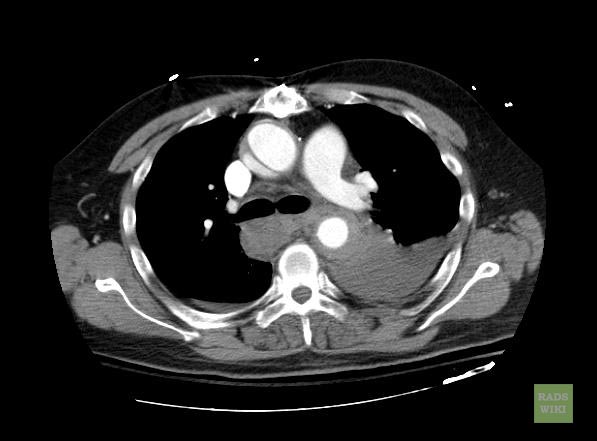
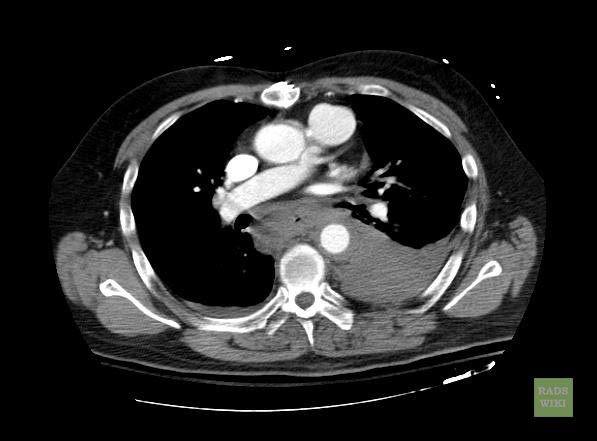
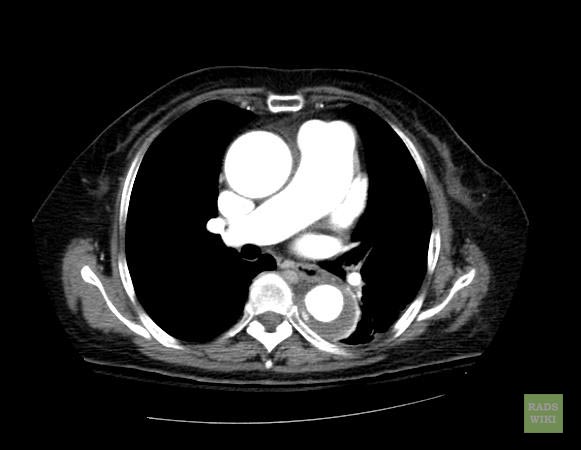
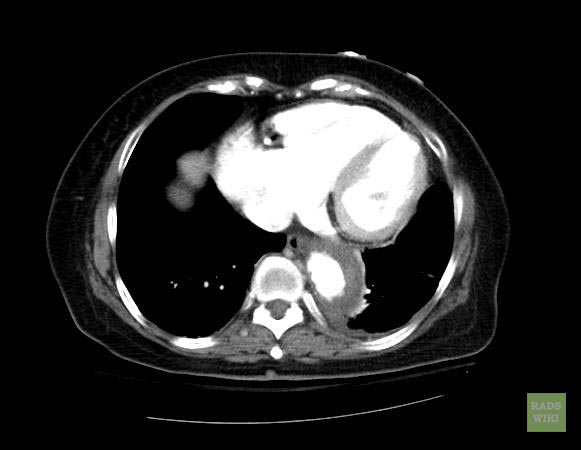
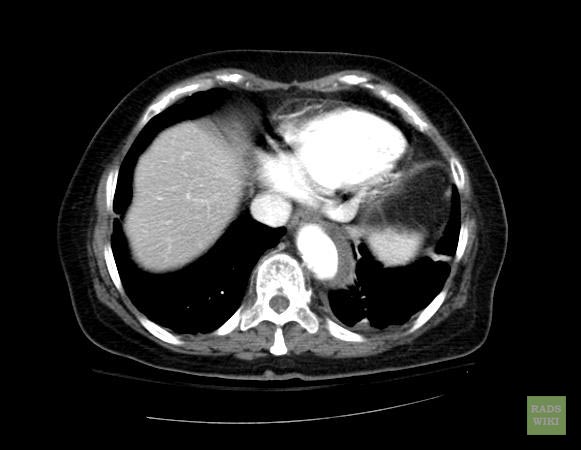
- Macura, Katarzyna J., Corl, Frank M., Fishman, Elliot K., Bluemke, David A. Pathogenesis in Acute Aortic Syndromes: Aortic Dissection, Intramural Hematoma, and Penetrating Atherosclerotic Aortic Ulcer. Am. J. Roentgenol. 2003 181: 309-316.
- Gomez-Jorge, Jackeline. E-medicine rads article